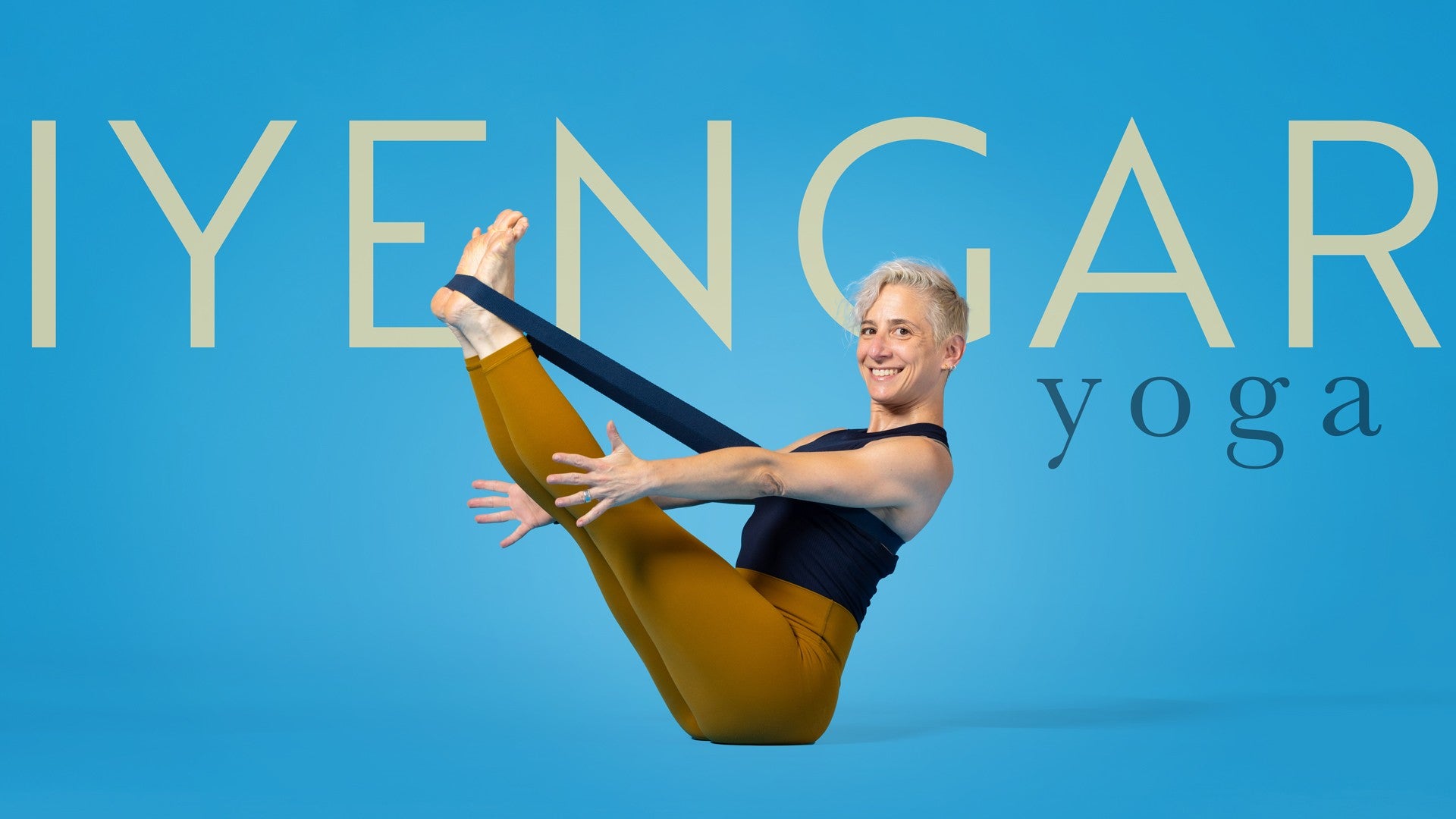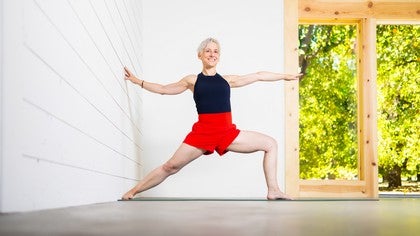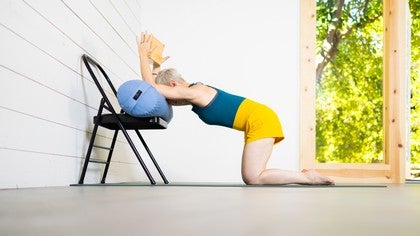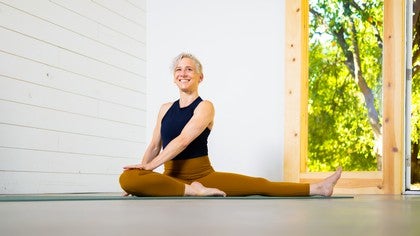Description
Transcript
Read Full Transcript
Hello, everyone. Welcome. So in today's session, we are going to focus on fundamental standing poses. And these usnas, these poses are often seen as, you know, beginner type poses, but I'd like to present to you a little bit of nuance and this idea that we are having our mind in multiple places at the same time when we go through the practice. Okay?
Let us begin with, but we're gonna go at it one arm at a time. Okay? So stand in, but for this first, separate your legs. So give yourself a little bit of space. Stand up tall. Okay. Lift your toes up, spread your toes, and take your mind to the bottoms of your feet. K.
Find those three points of the foot, big toe mound, inner heel, and then the outer edge of each foot. Press those three points of the foot strongly down, lift your kneecaps up, thighs up, move your thighs back, chest up. Okay. Now one armed Urdava, hastasana. Raise your right arm up to the ceiling and now reach up. Lift there. Okay. Lower that arm down and second arm.
Raise the left arm up. Lift and lengthen. Stretch to the entire side trunk. Lower the arm down and now raise the right arm up again. Lift in lengthen.
And from your wrist, lift the sides of your waist. Extend. Now as you lower the right arm down, raise the left arm up, reach and lift, lengthen. As you lower down other arm up. Okay. And now go a little faster. Switch.
Switch. Switch, switch, switch, lower both arms down. Okay. Arms by your side. Chest up. Breathe.
Okay. Now, Urdha Astasana, both arms at the same time, but we're gonna enter this Asana, in a couple different ways. Okay. So to begin with, extend your arms out to the side, broaden across your collarbone. So from your center line, out towards your middle fingers, extend Now turn your palms up, roll your shoulders back and down, and reach into your fingers again. Now is if you're lifting something really heavy, raise your straight arms up, up, up, up, up, And as if your arm ends, not at the armpit, but way down here, ascend, ascend, press strongly into your heels, but reach up into your fingertips. Okay. Now look up at the ceiling.
Look at your hands and see that your hands are actually facing one another. Sometimes they do, they kinda turn a little bit, right, revolve the upper arm and make sure they're facing each other, reach up, Move the arms back more. Lower the arms down. Okay. That was Ervajastasana approach number 1, going in from the side. K. Let's compare that with a forward facing Urd Bha Astasna.
So here, just reach your arms straightforward. Palms absolutely facing one another. Extend through the underside of your arm. Reach there and then raise your arms up. It's almost like you're making a circle, right, underside of the arm, extend, extend, extend, and raise your arms up.
And again, from your wrists, lift your waist. Absolutely, lengthen. And then lower your arms down. Okay. 2 different ways accessing the same pose. One may be a little more available, a little less available, may just kind of trigger a slightly different response.
So without judgment, just notice that. Observe that. See how those different entries work for you. Okay. And now I'm gonna introduce yet another variation. Okay.
If you have a strap, take take that, use that, and just create a loop in your strap that's about shoulder shoulder width. And then place the strap on your wrists. And I've learned this by experience. You wanna shift the tail of the strap off to the side. You'll see why in a moment.
Okay. And then stand, again, feet a little bit apart, but be in Tadasna. Kneak ups up, thighs up, move your thighs back, and then hit your wrists out against the strap. Hey, like you wanna break the strap. Hit it out, hit out against it, and then start to raise your arms up. Hit out lift. Hit out lift.
Hit out lift. Keep going in this manner, hit out, lift, and then move the arms back. K. And if you move the tail to the side, it won't hit you in the face. Hit out lift more. Hit out lift more. Use this resistance here from the strap in your.
Raise your arms up and see. Are you maybe able to get those arms a little further back? Them before. Okay. And then release. Lower your arms down. Okay. Place this drop just off to the side. And stand one more time in your taasna, and let's go for k. Now here, if you're feeling stable, steady, you may decide to join your legs for Tadas.
Now feel free. Okay? But if there's any instability, if there's any issues maybe with your lower back, do, keep the space. Keep the space. Okay? Reach your arms straightforward. Now with the memory of this drop, hit out and see, can you create your own framework of resistance? Hit out, lift, hit out, lift, hit out, lift, and raise your arms up. Urd Vahastasana.
Lathan up through the sides of your body. From your wrist, lift, and lengthen, create space between each row of ribs. Now move those arms back. And then lower down. Okay. Tadas now.
Okay. Now one thing I mentioned at the beginning of class is this idea of having your mind in two places at once. And this comes up again and again in our yoga practice. And I know for myself, it's one of the things that I find super accident. Very interesting about the practice and keeps me really engaged.
So what I want you to look for next in your Urd Vahastasna, is when you're raising your arms up, okay, very often, the weight shifts forward. Right? So without consciously, wanting this to happen, the thighs may fall forward. K. This is often what happens. So this next time when you raise your arms up, can you press those thighs back? Back at the same time. K.
Avoid letting the weight shift. Okay. Let's let's try that. Ervajasasna. K. Stand tall. First, establish your taanas and legs.
Big broad feet, lift your kneecaps, lift your thighs, move those thighs back. And then why don't you pick your Urva Haastasana? You can go this way or from the side. Okay. Which one was most effective for you? Raise your arms up. Urdhasana. Thighs back.
Thighs back. Reach up into those fingers and move those thighs back. Alright. And then release. Lower your arms down. And, again, just stand, collect yourself.
Okay. Let's let's work a little bit more with that thigh action in tadasana. Okay? So collect, a block or a brick for yourself and the same way we gave our wrists, framework of resistance, something to touch against, we'll now do that for the thighs. And so you can take a brick and place it between your legs here as high up as you can manage, and you wanna just sort of look down, see that the brick is relatively straight. Right. It's not going all too wonky there.
And then join your legs, but do make sure that there's no unnecessary pressure on the outer knee. Right? For some, they can bring the legs right together for others. They need a little space still between the legs. So just work with what's comfortable here for you. Okay? And then be in your big broad feet, spread lift the toes, spread the toes, three points of the foot.
And if you have any confusion about those three points, feel free to check out the first lesson there where we go into it in a little more depth. Okay. Press down there, kneecaps up, thighs up. Now squeeze the brick. From the outer leg, squeeze the brick. And now literally as if someone standing right behind you and pulling the brick out, move that brick back, back, back, back, back. Okay. Now, if you see my side view here, when I push the brick back, my torso falls a little forward.
Not exactly what I want. Okay. I want the thighs to go back. But from the mid buttock still push forward and then stand yourself up. But when you stand yourself up, don't let the thighs fall forward again. Okay? Squeeze the brick, move the thighs back, slightly turn the thighs in, push the break back, and then mid buttock into the body.
Ascent. Ascent the front body. Tadasna. Squeeze the brick. Turn the thighs in, move the brick back, lift your chest up. Okay. And then release.
Right? Different way of using the legs, different way of becoming involved, engaged with your legs. Alright. We will do this one other way. Okay? So now remove that brick. And what I want you to do next is stand near a wall, and you're gonna place the brick just under the buttock. So it's almost like a little shelf for your buttocks that crease under the buttock there. Okay. And then position yourself.
You wanna stand about a brick width out from the wall, and then you place that little shelf against the wall and just walk back a little. Like, make sure that the heels are right under you, right under you. The legs are not angular. Okay. I like to work with little space between my legs. I'd recommend that for for you in this position. And then again, nice wide feet spread the toes.
Press the big toe mound, inner heel, outer edge of the foot, and then lift your kneecaps, lift your thighs. And now Push your thighs back against the brick. Okay. Chest up. Push your thighs back. Now when you're pushing your thighs back against this brick really feel which part of your back thighs are touching the brick.
K? Does it feel even? Right? So we've got sort of the inner leg and the outer leg. And I feel fairly safe to assume that for most people, when they press their thighs back against the brick, you will feel the brick a little more intensely here on the outer thigh. And what I want you to do is spread the back of your thigh and see can you get this inner edge of your thigh? To also touch the brick with just as much, emphasis. Okay? Broad in the back of your thighs.
That's what I mean. And press into the brick. Hey, it sounds really simple. Probably doesn't look all that much, like you're doing all that much, but it is not an easy action to connect with. Right? Yoga's about embodiment, being in your body. Connecting with that specific part of your body.
Broad in the back thighs and move back there. Move back there. Chast up. Okay. And then release. Okay. Take the brick out.
And then just stand in your Tarasna and see if you can mentally insert the lessons that we've just worked on. Okay. Imagine that you have a brick between your thighs. Squeeze out imaginary brick and move the brick back. Move the brick back. Mid buttock, into the body, lift the front body up, but continue to move your thighs back.
Visualize next, that brick between behind your thighs, right, that top third of the back thighs and broaden the back of your thighs along that imaginary brick. K? So it's that level of nuance that can come into play in these standing us nuts. Okay. And then release rest for a moment. Alright. We are gonna move next into, k? And we'll do a little bit of jumping.
So one caveat, when you're jumping, it can be it's it's a nice way to raise the energy, and it can be fun. Okay? But if you are working with any condition that, might prevent you from jumping, please don't jump. Okay? It's not necessary. I can show you how to step into the pose as well as how to jump into the pose. K. If you're stepping, you're literally going to step and step. Ervahastaparasna.
K? And then you step back. K? If you're jumping, you start with your legs together, bring your fingertips together, and then as you inhale, jump your legs apart. Okay? I just wanna practice this a few times, jumping the legs apart, and jumping the legs back together. Tada sna. Okay. Let's go a couple more times. Finger tips together.
As you inhale, jump your legs apart. Okay. Now see, can you do it without looking down? So find a spot straight ahead, maybe just a little bit above eye level. Keep your eyes there. Trust that the floor is there and jump back.
Tadasma. Fingertips together and Spread your legs and come back. Tadasna. Okay. Good stuff. Okay. We'll take it one one more.
I wanna I was gonna say one step further, it's not exactly further, but towards another pose, Pajj Vahasta. Okay? In the standing poses, sometimes the stance needs to be fairly wide. But the jump, our jumps aren't there yet. Okay? So if you're practicing your jumping, feel free to jump and then spread a little wider if you feel you need that. No. That's absolutely acceptable.
Okay. Now in the parsva, the sideways variation, you're going to, in one motion here, you look at my right leg, one motion, turn the right leg out. So externally rotate that leg. Take it back in. Okay. Let's do a couple times here on this right side. Take the leg out.
Turn it back in. Leg out. Take it back in. So notice I'm still facing forward. Turn the leg out, take it back in. Okay. I got a little wide there.
It's sliding as I'm doing this. Okay. Now left side, turn the left leg out 90 degrees. Turn at the hip. Turn the knee. Turn the thigh. Take it back.
And then again, rotate the left leg out. Take it back one more time. Turn the leg out. Turn the knee out, turn the thigh out, take it back. Okay.
And then jump back. Stabilize, steady yourself. Alright. So that positioning that we just did is nice to work like that. Just turn the leg out, turn it back in, a way of almost warming up the hips and getting a little bit of mobility in that area. There is another way to enter this asna that I find really deep in the hip in a good way.
And it's nice and stable. And I find a really effective way to keep the the spine the lower back, especially stable in the standing poses. So I wanna demonstrate that for you here. And I think the clearest way to do so is I'm going to stand on the back of my mat here with half of my foot off the mat. So the mat is essentially at my arch is a dissecting my arches.
Okay. And please try this with me and feel the difference. Feel how this stance changes a little bit. Okay. So on your right foot now, I want you to turn your foot 45 degrees out. K? So just halfway out. Now here, keep those toe mounds down. Lift the heel.
Eggsternally rotate. And now the heel is just, just just on the mat. Okay. Turn. And feel what's happened in that right hip. Feel if there's a little bit of a connection. Okay. Release.
Take it back. Okay. And just to really drive home that comparison. Right here, right like 90 degrees. Just turn it out. Feel what's happening in the hip.
Take it back. Okay? Now do it again right side. Two step process. Okay. Two steps. Turn the toes halfway. Lift the heel. Now deep in the hip socket, externally rotate, turn turn turn the knee, turn the hip, stand up straight. K.
Kneecap up, thigh up, parsvahastaparasna. Feel what's going on at your outer right hip. Okay. Release and second side. Left leg. K. Let's do the comparison. So on the left side, 1st 90 degrees.
Just Take it out. Take it out. Bring it back. Okay. One more time. Take it out. Bring it back. Now two step process turn the toes halfway. Now lift the heel and swivel the heel under.
Swivel it under. Turn the knee out, turn the thigh out, straighten the leg, parsvahastapadassan, suck in at that outer hip, feel that outer hip. Gonna extend the arms. Okay. And then release, take it back one more time, 2 step process.
Turn the toes out halfway. Lift the heel. Swivel. Swivel. Swivel. Turn the knee. Turn the thigh. And then your heel here is in line, maybe with the big toe, like the front of the arch, the big toe of the back leg. Pajvahasta.
Anybody who's working with lower back issues, hip issues, this kind of alignment can be really, really helpful. And you can even turn the heel beyond. That will even even more so get into the hip, right, to to suck it into the socket. Okay. And then release. And here, you can heel toe yourself back together and stand in. Be here for a moment. Observe.
Even just this work here, what we've done so far, observe the texture, the touch, the quality of touch of each foot to the floor. And then notice as well your state of mind. Right? There's a there can be, a a groundedness that comes. From this work. Okay. Let us move along And now we'll build this, incorporate this into Virdrebadrasna 2. Warrior 2. Okay. So let's work with, the back leg at the wall.
K. So I'll show here you'll start with your right leg against the wall here, and you want the whole outer edge of your foot against the wall. K? Then take a nice big step into the room, like so. And, let's start with the hands just on the hips for right now. Okay. Now picking up from where we left off 2 step process, Okay? Turn your left foot, 45 degrees out. Now lift your heel up.
Don't let the toe mounds move. Swivel the heel under, turn at the hip, place your foot down straighten both legs. Now this, again, keeping your mind in two places at one time. From the outer edge of your right foot, that right heel, push the wall Suck that right hip in. Now bend your left knee. Now as you bend it, turn the leg out. Okay.
You can extend the arms here like this. Dip down with your right heel. Push the wall. Sit down into your left buttock, sternally rotate that leg. Drop your shoulders.
Lift your chest. Be here. Hey. You can even turn your head. Look over your middle finger. Push the wall with that back foot.
Really push. The mind is gonna pull you towards the bent leg, but be in your back leg. Okay. Push the wall straight in your front leg. And then turn your foot forward. And from here, you can jump back or heel toe yourself back together. Okay? Both are fine. K? Tadasna. Alright. Turn yourself around and we'll go for the second side.
This time, left leg goes into the wall and take a nice big step into the room with your right foot. K. Now, 2 step process again. Turn your right foot, 45 degrees out. Lyft the heel up, swivel the heel under, swivel under, turn your knee, turn your thigh, roll that right buttock under. Now can you keep your brain, your mind in that back heel? Push the wall.
Wanna roll the outside edge of your left foot down and push the wall. Now suck this hip in. Bend your knee. Bend it. Bend it. And you can look at your knee.
If the knee is falling towards the big toe, you gotta get a little more rotation. Turn the thigh. Sit down into that right buttock and then extend the arms. Be here. Are you still pushing the wall with that left heel? Push. Push. Push. Rotate that right thigh out.
Now lift your chest. Drop your shoulders. Turn to look over your middle finger. Breathe. Now, again, back leg.
Push the wall with your outer foot. Stand up straight. Turn your foot forward and jump or step back. Okay. Carrying on. We're gonna move next.
From verbatrossnet to to Utita, parsvokanasna. Okay. Now in this Asna, We have some options. Okay. So I will show you a couple of things. The starting place is the same. Nice big step.
And then 2 step process, toes out, heel under. Now in Otita Pajevo, Kanasna, you really do want a wide stance. Okay? So when you take the beginning, the verbiagerosima 2, and you bend, you're looking for a square. Right? You want the knee more or less aligned over the ankle here like this. Okay. So it's gotta be nice and wide.
Then from here, push the wall with your back foot and hinge. Like, almost like you're sliding your palms straight across up countertop, extend, and then lower your arm down. And however much space there is there, that's how much height you need. So it may be a brick on this level. I mean, it may be the floor. It may be a tall brick, or it may even be one brick with another brick on top. Right? So you can work that out. Be reasonable about it.
And then go work at this height today. And then create a fulcrum. Press your leg against your arm, arm against your leg, and turn yourself to the right. Okay. Now, what about that back leg? Did it just collapse or push the wall? Roll the outside edge of that back foot down? Push the wall. Hand on your hip, wrap your elbow back, chest up.
Okay. Push the wall again, and then swing yourself up. Turn your foot forward. He'll tow yourself back together. Standing totson. Okay. 2nd side.
Turn yourself around and this time, left leg into the wall. Nice big step into the room with your right foot, and you'll have your brick behind you. Okay. 2 step process. Turn the right foot, 45 degrees out. Swivel the heel under.
Turn your knee, turn your thigh, and then lift the kneecap. Lift the thigh, straighten your legs. K. Suck your left hip into the body and bend your right knee. K? Push the wall with your left foot there, sit down into your right buttock. Now from here, extend your right arm, and hinge to the right side. Okay. The arm doesn't end at the armpit.
It ends at the hip. So lengthen the waist. Extend. Maximize that length and then lower your arm down and see where does it go? Just fill the space. However, much height you need, you take it. Okay? Press your leg into your arm, arm into your leg, and turn yourself to the left. With your left arm on your hip here, you can wrap that elbow back, roll the shoulder back, Push the wall with your left foot, rotate your right thigh out, and turn your abdomen right to left.
Chin up a little, beginning stage here, Utita Pajjwoconasana. Hold it. Alright. Push the wall with your left foot and then swing back up. Straighten both legs, turn your foot forward, heeltoe yourself, back together. Okay. Now what fun would it be to, only do the pose once? Right? We have to do it a second time.
And really see the impact. Okay. So go again. Right foot into the wall and turn your left foot out. Okay. Turn the toes out, roll the heel under. Roll the outside edge of your right foot down, push the ball. Now suck your hip in and veer badrasana 2.
K? Reach. Come to where we left off. Hinge at the hip, extend, and then arm on the brick. Find your height, create the fulcrum, turn your abdomen to the right. Alright. Push the wall again with your right heel.
Revolve externally rotate that left thigh. Alright. Now reach your top arm up to the ceiling. Turn the palm towards your head and now reach over your head from the outer edge of your right foot all the way to the middle finger, extend, and then turn yourself to look up underneath your lifted arm. Okay. I'm gonna sneak one more thing in here. Now take the arms straight up to the ceiling.
Reach up there, push the wall with your back foot, and now pressurize those three points of your left foot into the floor. And feel like you can slide the floor away from you as you straighten that leg and come into turn your abdomen to the right. Okay. Push the wall with the back leg. Inhale. Swing yourself up. Turn your foot forward and heel toe yourself back together.
Breathe, stabilize, Tawdawson. Okay. Last time, second side. Just shift your break and left foot into the wall. Nice big step into the room.
Okay. 2 step process should be coming maybe little more like second nature here. Turn the toes out. From the hip socket externally rotate swivel the heel under. And verabradrasna, 2.
Bend your knee. Push the wall with your back foot. Sit down into your right buttock and revolve. Hand comes down, find your brick, fulcrum, leg against arm, arm against leg, and turn your abdomen to the left. Okay. Now reach your left arm straight up to the ceiling.
Turn the palm, turn the arm into the socket, and now reach over your head, and find that dialogue from the outer edge of your left foot all the way to the middle finger, extend, and now turn yourself to look up underneath that lifted arm. Otita parsvoconasna. Push the wall with your left foot. Turn your right leg out. Reach into those fingers.
Okay. Raise the arm back up. Reach up. Like, there's a rope on the ceiling. X. Stand up. Pressurize your right foot into the floor. And now, like, you're sliding the floor away from you.
Push. Push. Push. Stay low in the side trunk. Transition, otika, turn your abdomen to the left. Head back a little bit, chest open, Okay. Push the wall with your left foot. Swing yourself up.
Turn your foot in and heeltoe yourself back together. Take a moment, find your breath. Okay. We're gonna go next into a supported Citu Banda Sarangasna. And It's it's modified.
It's gonna be a bent leg variation. I quite enjoy it. I hope you like it. And you will need a chair. Okay. So a chair at the wall is ideal.
I'm gonna bring your chair right up against the wall, and then you'll also need a brick within reach. Okay. And it can be a wood brick, a foam brick, whatever you've been using. Alright. Lay yourself down. In front of your chair. We'll be pretty close to your chair.
You're gonna lay on your back. Scoot yourself in so that when you place your feet up here, you've got a little bit of purchase. Right? You're gonna end up lifting yourself up. And then take hold of the sides of your mat, broaden your collar bones, and then roll your shoulders under. And you can even do this one at a time, lean to the left, roll the right shoulder under, roll to the right, lean to the right, roll the left shoulder under. Okay?
Now pressurize your feet into the chair. And lift yourself up and roll even more onto your shoulders. Okay? Then reach for your brick. And place it right underneath your sacrum. Okay. And see if you if it works for you to have the brick on the highest elevation, then please feel free.
Go ahead. If that feels a little bit too intense, then By all means, you can take it down a notch. You can work second elevation. You can even work on the flat elevation. Okay. Pick one that works well for you. Adjust yourself so that you feel secure on top of the brick there. And then extend your legs.
And what I find is the nicest is when the chair is just kind of hooked into the back of your knee. K. That's you've got that nice support. I just kind of finagle it here with my feet. And get the back of my knee to feel like it's supported. K. And then separate your legs as wide as the chair will let you go.
Turn the thighs in. And then be here. Optimum soft, quiet, face soft, and just be breathe here. Inhale. Exhale.
Hey. There's not much for you to do at this point. Just receive the shape. That these props are helping you create. With each exhalation, Let your abdomen soften a little more. And just connect here with the softness of your breath.
Hey. Now you can stay in this Sichu bandha serving Gosna for a little longer. But for those of you who wish to come out, just go ahead and bend your knees one leg, then the other. And then you can still grip the sides of your mat, push into the chair. Just lift your pelvis a little. And then Lower the brick to the lowest elevation.
K. Roll the buttocks away from your waist as you lower down. Just pause there. Like, so, like a transition here. Take a few breaths. And then again, lift up.
Remove the brick completely. And slowly lower yourself down. K. And then you can end here. In a flat back shavasna with your legs on the chair. Let go completely.
Allow the floor and the chair to support you. Okay. Enjoy that Shavasna. This, this brings us to the end of today. Thank you so much, and I look forward to practicing with you again.
Iyengar Yoga: Stephanie Tencer
Comments

You need to be a subscriber to post a comment.
Please Log In or Create an Account to start your free trial.













